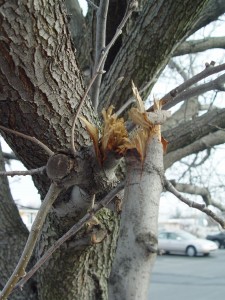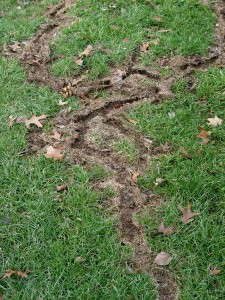Time to get to work… er, I mean, play!
March 6th, 2010
The snow is gone enough that we can get out there and start to reconnect with our long-lost gardens. Soon, it’ll all be gone (the snow, not the gardens).
I’m getting a ton of questions about broken branches – especially on Japanese maple, hydrangeas, boxwoods, white pines and similar brittle-branched species.
Except in really horrendous break-aparts, these plants are going to live. They just might be misshapen, lop-sided or “saggy” for awhile until they fill back into shape. You can help with judicious pruning.
First, anything that’s snapped off or that’s hanging by a thread is a goner. Prune it off as soon as you can get to it. Shattered and splintered breaks also are unlikely survivors.
Clean splits are a different story. You might be able to bind those back together. Use a piece of old nylons to wrap the split parts back together if the branch is the size of your pinkie or less. If it’s bigger, drill a small hole and use a small galvanized bolt (or two) to hold the break together.
If the wood hasn’t calloused over, it’s possible the split will fuse together. You’ll know by summer. If the branch puts out new growth, it worked. If it browns out, it’s dead. Then prune off the dead wood back to just above the next live shoot.
For early-spring bloomers like azaleas, lilacs and weigelas, limit pruning now to just taking care of the breaks. If you do any heavier reshaping, you’ll cut off the flower buds that would’ve opened in April or May. Do that kind of work right after these plants bloom.
Later bloomers such as the tree-type hydrangeas, butterfly bushes and rose-of-sharons can be whacked back as needed any time in the next few weeks. These put out flowers on wood that grows this season, so getting rid of the old wood going into the season is OK.
Isn’t it amazing how many of the spring bulbs pushed up their foliage shoots even under 2 to 3 feet of snow? They’re going to bloom just fine and on schedule (barring any Arctic windstorms from here on out). I’ve got snowdrops blooming already and have plenty of daffodil shoots up. Some of them have yellow tips, probably from lack of sunlight buried under the snow. I’m optimistic the leaf tips will green up shortly. Even if the yellowing is from cold injury, that won’t affect the flowers. The flower shoots are still safely nestled under the mulch.
The snow cover was great for protecting tender and borderline-hardy perennials. And we’ll be going into the season with good soil moisture… not like a few years ago when we had some really dry winters.
One other thing to watch for – surface tunnels on the lawn from voles. These are the little rodents that venture out onto the lawn under cover of snow to feast on the tender blades and roots. Just rake away any browned-out left-overs and scatter a little grass seed in early April to help fill in the tunnels. Even without overseeding, the existing lawn will do a fairly good job filling back in all by itself.
I can’t wait for a few warm days to finally get out there and get things cleaned up. Remember, if the ground is thawed, St. Patrick’s Day isn’t too early to plant the peas. I do my cabbage, onions and spinach toward the end of March.









